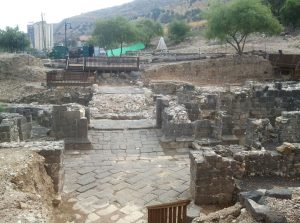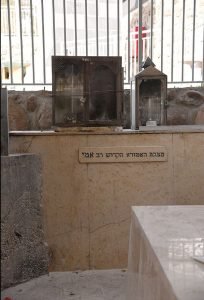One of the names that occurs frequently in the Gemara is that of Rabbi Ami. He shows up here on our daf in the context of a disagreement about taking an oath:
“His statement serves to exclude the opinion of Rabbi Ami, who says: With regard to any oath that the judges administer, one is not liable” (Bava Metzia 36a)
Rabbi Ami was a third generation Amora who spent most of his life in Tiberias. He lived towards the end of the third century CE, under the rule of the Roman empire, in what had become the most important Jewish city in the Land of Israel. Tiberias was the home of a prominent yeshiva and of the Sanhedrin and eventually it was the place where the Jerusalem Talmud was compiled. According to the Gemara, Tiberias had thirteen synagogues at this time, although Rabbi Ami chose to pray in his study hall (Berachot 8a).

Downtown Tiberias in Roman times
Hanay, CC BY-SA 3.0 <https://creativecommons.org/licenses/by-sa/3.0>, via Wikimedia Commons
Rabbi Ami had many prominent teachers but his main teacher was Rabbi Yochanan who he eventually succeeded as head of the yeshiva. Rabbi Yochanan is often quoted by Rabbi Ami and he served him in life, as in this example:
“Rabbi Yocḥanan was once going up stairs, and Rav Ami and Rav Asi were supporting him. . .” (Ketubot 62a )
and mourned him in death (Moed Katan 25b). Like Rabbi Yochanan, who is often mentioned alongside his sparring partner and close friend, Resh Lakish, Rabbi Ami also had a significant colleague: his chavruta Rabbi Asi. The two are mentioned so often together that sometimes it is unclear who held which opinion:
A prominent member of the Tiberias community, as well as a Cohen like Rabbi Asi, Rabbi Ami also was heavily involved in adjudicating disputes. He and Rabbi Asi had a practice of always allowing potential litigants to approach them while they were learning:
“Rav Ami and Rav Asi would sit and study between the pillars. And each and every hour they would knock on the bolt of the door and say: if there is someone who requires judgment, let him enter and come before us.” (Shabbat 10a)
Eventually Rabbi Ami became not only the head of the yeshiva but the premier halakhist in the Jewish world. When he issued a ruling once, he prefaced it with these words:
“From me, Ami bar Natan, Torah emerges to all of Israel” (Gittin 44a)
Rabbi Ami and his study partner Rabbi Asi appear in many different contexts. The Yerushalmi tells how they and Rabbi Hiyya bar Abba would travel together at the behest of Rabbi Judah Nesiya, the Nasi of the Sanhedrin, in order to see that Jewish communities were teaching their children properly:
“Rebbi Judah Nesiya (grandson of Rebbi) sent Rebbi Ḥiyya, Rebbi Asi, and Rebbi Ami to tour the towns of the Land of Israel in order to give them Bible and Mishnah teachers. They came to one place where they found neither Bible nor Mishnah teacher. They said to them, bring us the watchmen of the town. They brought them the stewards (administrators) of the town. They told them, these are not the watchmen of the town, they are the destroyers of the town. They asked them, and who would be the watchmen of the town? They told them, the Bible and Mishnah teachers.” (Yerushalmi Hagigah 1:7)
They studied and prayed together, as well as judged cases, all in their study hall. They also were involved in charitable acts, making sure that the dead were buried and even going so far as to do the manual labor of putting up a huppah for a third rabbi, Rabbi Elazar:
“Rabbi Ami and Rabbi Asi were once tying a wedding canopy for the wedding of Rabbi Elazar.” (Berachot 16a)
Perhaps their close association and friendship led them to another important insight, often quoted in conversations about Judaism’s take on mental health. When they interpreted a verse from Proverbs about worry, they disagreed and went in two very different directions:
“If there is care in a man’s heart, let him quash it [yashḥena]” (Proverbs 12:25). Rabbi Ami and Rabbi Asi: one said: he should forcefully push it [yasḥena] out of his mind. And one said: he should tell [yesiḥena] it to others” (Yoma 75a)
One rabbi thought that worries should be pushed away and not shared, perhaps looking to friendship for distraction rather than comfort. However, the other believed that worries should be talked out, and in doing so their burden will be lessened.
Like many periods in Jewish history, Rabbi Ami’s time held many challenges for the Jewish people. He insisted on not adding to their burden, ruling that the rabbis should not impose too many hardships on the people (Taanit 14b) but he also recognized the steel that Am Yisrael is made of:
“’The Lord said to Moses: I have seen this people, [and behold, it is a stiff-necked people]’ (Exodus 32:9) – what is, ‘behold, it is a stiff-necked people’? . . .. Rabbi Yitzḥak bar Redifa said in the name of Rabbi Ami: You think that this is derogatory, but it is only in their praise: Either Jewish or hanged.” (Shmot Rabba 42:9)
Our stubbornness is actually to our credit. The Jew would rather be martyred than leave his faith.
Rabbi Ami lived much of his life in Tiberias and the traditional site of his grave is there, next to his colleague Rabbi Asi, and alongside later and earlier great rabbis like Rabban Yochanan ben Zakkai, Maimonides and Rabbi Isaiah Horowitz. Surrounded by scholars, in death as in life, Rabbi Ami’s words live on in his teachings.

Rakoon, CC0, via Wikimedia Commons










